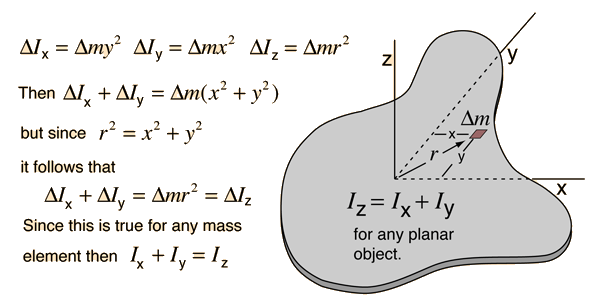Define perpendicular axes  ,
,  , and
, and  (which meet at origin
(which meet at origin  ) so that the body lies in the
) so that the body lies in the  plane, and the
plane, and the  axis is perpendicular to the plane of the body. Let Ix, Iy and Iz be moments of inertia about axis x, y, z respectively, the perpendicular axis theorem states that
axis is perpendicular to the plane of the body. Let Ix, Iy and Iz be moments of inertia about axis x, y, z respectively, the perpendicular axis theorem states that
 ,
,  , and
, and  (which meet at origin
(which meet at origin  ) so that the body lies in the
) so that the body lies in the  plane, and the
plane, and the  axis is perpendicular to the plane of the body. Let Ix, Iy and Iz be moments of inertia about axis x, y, z respectively, the perpendicular axis theorem states that
axis is perpendicular to the plane of the body. Let Ix, Iy and Iz be moments of inertia about axis x, y, z respectively, the perpendicular axis theorem states that
This rule can be applied with the parallel axis theorem and the stretch rule to find moments of inertia for a variety of shapes.
If a planar object (or prism, by the stretch rule) has rotational symmetry such that  and
and  are equal, then the perpendicular axes theorem provides the useful relationship:
are equal, then the perpendicular axes theorem provides the useful relationship:
 and
and  are equal, then the perpendicular axes theorem provides the useful relationship:
are equal, then the perpendicular axes theorem provides the useful relationship:Derivation
Working in Cartesian co-ordinates, the moment of inertia of the planar body about the  axis is given by:
axis is given by:
 axis is given by:
axis is given by:
On the plane,  , so these two terms are the moments of inertia about the
, so these two terms are the moments of inertia about the  and
and  axes respectively, giving the perpendicular axis theorem. The converse of this theorem is also derived similarly.
axes respectively, giving the perpendicular axis theorem. The converse of this theorem is also derived similarly.
 , so these two terms are the moments of inertia about the
, so these two terms are the moments of inertia about the  and
and  axes respectively, giving the perpendicular axis theorem. The converse of this theorem is also derived similarly.
axes respectively, giving the perpendicular axis theorem. The converse of this theorem is also derived similarly.
Note that  because in
because in  , r measures the distance from the axis of rotation, so for a y-axis rotation, deviation distance from the axis of rotation of a point is equal to its x coordinate.
, r measures the distance from the axis of rotation, so for a y-axis rotation, deviation distance from the axis of rotation of a point is equal to its x coordinate.
 because in
because in  , r measures the distance from the axis of rotation, so for a y-axis rotation, deviation distance from the axis of rotation of a point is equal to its x coordinate.
, r measures the distance from the axis of rotation, so for a y-axis rotation, deviation distance from the axis of rotation of a point is equal to its x coordinate.

